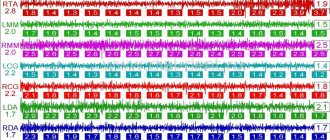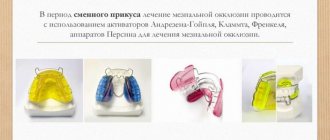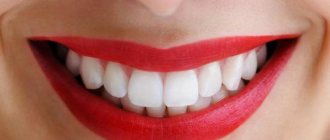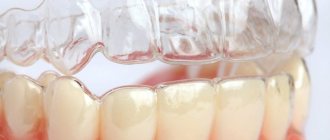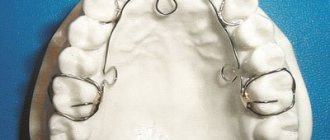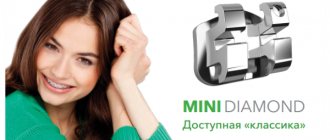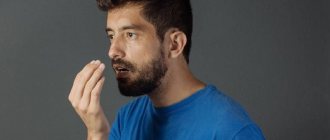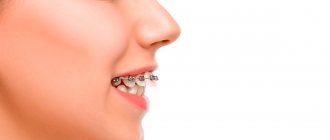A child’s malocclusion is not a problem today. An orthodontist will definitely be able to solve it. Basically, parents resort to his help when the child is 5-6 years old. The most important thing is to consult a doctor in time without waiting for the eruption of permanent teeth. There are different ways to correct a bite in children. A child's bite can be corrected faster than an adult's. A child is a growing organism. His teeth are easy to move during this period.
Periods of occlusion
There are several periods of development of occlusion in humans:
- First period: newborn period. During this period, babies still have no teeth.
- Second period: teething time. It begins from the moment the first baby tooth appears and ends with the eruption of all twenty.
- Third period: time of mixed dentition. It begins from the moment the milk teeth are replaced by permanent ones.
- The fourth period (final): the time of formation of a permanent dentition. During this period, all molars should be in the mouth.
Reasons for development
Why does a child develop malocclusion? The causes of its occurrence are divided into congenital and acquired.
Causes of congenital malocclusion:
- infections affecting the fetus;
- maternal diseases complicating the development of the fetus;
- maternal abdominal injuries;
- negative effects of poisons and drugs;
- trauma to the baby's facial bones during childbirth;
- congenital shortening of the frenulum of the tongue and lips.
Unlike congenital ones, acquired closure disorders are caused by diseases and bad habits.
These reasons include:
- pacifier abuse;
- the baby constantly sucks and chews objects (pencil, finger);
- bad habits (biting your lip, propping up your chin);
- lack of prosthetics, teeth falling out prematurely;
- Consequences of rickets before the age of one year;
- pathologies of ENT organs, with impaired nasal breathing (deformation of the nasal septum, enlarged adenoids);
- endocrinopathies;
- diseases of the musculoskeletal system;
- pathological posture in sleep;
- extensive caries of molars;
- injuries to the facial part of the skull;
- malignant tumors of the facial bones;
- purulent-necrotic processes of the jaws (osteomyelitis, periostitis);
- early or delayed eruption of teeth.
Often the formation of closure defects is caused by several reasons. They need to be identified in order to determine the optimal tactics for correcting the defect.
Ways to correct bite in children
There are several ways to correct a child’s bite:
1. Myotherapy. With its help, the bite is corrected in children without braces. The method includes special exercises that perfectly train the chewing and facial muscles. The method is popular in the treatment of young children (from four years old). When prescribing and applying such treatment, it is very important to know that the child consciously understands why and how he needs to perform the exercises correctly. During classes you cannot do without adult supervision. You should also remember about the regularity of exercises.
2. Hardware. The method consists of the use of special structures (braces, trainers, plates). These devices can be used after the age of six.
3. Surgical. The method involves performing surgery on the jaw.
4. Orthopedic . The bite is corrected using orthopedic structures (veneers).
5. Comprehensive . Consists of several methods.
Diagnostics
In addition to a visual examination, the orthodontist can measure the gap and assess the degree of open bite for further treatment. There is a possibility of direction for more in-depth research that will give a complete picture:
- teleroentgenogram;
- orthopantomogram;
- taking impressions.
Often a specialist sees the presence of a combination of disocclusions: distal open bite, mesial.
To collect information about the patient and the progress of the correction, before and after photos are taken.
Application of records
The design does not require constant wear and is a removable device. It is usually removed during meals or under other circumstances when the baby feels discomfort from it.
The design has several metal elements (screws, hooks, arcs and springs). It is made separately for each patient. The manufacturing procedure is as follows: an orthodontist examines, takes impressions of the jaw, a plaster model is cast in the laboratory based on the impressions, and a plate is made based on the resulting model. The orthodontist independently adjusts the position of the springs and hooks. Such actions by the doctor allow you to move the teeth and dentition in the right direction.
Plates effectively correct malocclusion in the early stages. But sometimes you can hear from friends that the above-described structures did not allow their children to correct their bite. It is not true. With constant wear and compliance with all the recommendations of the orthodontist, the desired result will definitely occur. Although the plates are not permanently installed devices, they must be worn without removing them. It is allowed to remove the structures only when eating, brushing your teeth and in some other life situations (for example, when taking photographs).
Some capricious children do not want to wear records. The task of parents is to convey to the child information about the need for treatment. At the same time, there is an urgent need for constant monitoring of the child. You will need to monitor whether the child has removed the device.
Kinds
There are several types of occlusion anomalies; in pediatric orthodontics, there are six.
The following types are distinguished:
- deep – it is characterized by excessive overlap of the upper jaw of the lower jaw;
- cross - with this violation of closure, there is underdevelopment of the jaws on one side, with a characteristic intersection of the lower and upper dental arches;
- mesial - it is typical for the lower jaw to move forward, with the lower incisors overlapping the upper ones;
- open - with this disorder there is no closure of the upper and lower incisors, the patient has a gap between them;
- distal - with this anomaly, the upper incisors move forward, this sign is combined with underdevelopment of the lower jaw and a reduction in the lower part of the face;
- underestimated - characterized by underestimated closure, due to premature abrasion of teeth.
Before starting correction, it is necessary to establish the type of occlusion violation.
Using trainers
Trainers are not made from casts. They are produced by special companies. They are made from silicone. Such designs are also widely used to correct malocclusion in early childhood.
Trainers are removable devices. This device for correcting malocclusion in children only needs to be worn for a short time. For example, at night and three hours during the day.
The material allows the teeth to quickly adapt to the correct position. In addition to the main treatment, trainers are used to consolidate the achieved results in teeth alignment and to eliminate certain defects.
The main indication for the use of trainers is crowded teeth. In addition, the devices effectively straighten teeth if there are gaps between teeth. However, correction of bites with large gaps is more relevant to adult patients. In children with baby teeth, the defect will correct itself when permanent teeth appear.
In addition to trainers, modern orthodontic practice uses LM-activator and myobrace devices.
A favorite benefit of trainers for patients is their invisibility. Little patients who wear such designs do not feel discomfort when communicating.
Dental trainers are recommended for use in the following cases:
- It is impossible to install an effective braces system.
- The patient's speech is impaired.
- There is an urgent need to wean yourself from a bad habit: thumb sucking.
- Improper swallowing.
- Difficulty breathing through the nose.
- With a deep, open bite.
- With a small bite defect.
Types of trainers in orthodontics
- Initial (blue). It is made from a very flexible material.
- Final (pink, red). The trainer material is harder. It has a stronger effect on the teeth than the initial trainer.
At what age should you start correcting bites in children with trainers? It's better if it's 5-8 years. The method is effective and painless. Early treatment for malocclusion in children will give a 90% success rate.
At the age of 6-12 years, the first teeth of babies change to permanent ones. During this period, the jaw bones grow very actively, giving space for new teeth to emerge. If you use trainers during the specified period of change in bite, then in the future the jaw will develop correctly. This will avoid expensive treatment in the future.
Trainers must be washed after food has entered your mouth. You need to hold them firmly in your hand. This device must not be allowed to fall. Even for disinfection, trainers should not be boiled or washed under very hot (and, conversely, cold) water.
You should always remember that there are leveling devices in your mouth. Therefore, it is forbidden to chew trainers and squeeze them tightly with your teeth.
Trainers need to be carefully monitored. Carry out periodic inspection. Damage is not acceptable. It is better to store devices in a special container.
Short frenulum of the tongue, upper and lower lips
- A short frenulum of the tongue is, in most cases, a hereditary problem that leads to problems with sucking, diction, and in complex cases, over time leads to recession (loss) of the gums on the lingual side of the lower dentition. Often the best option is frenuloplasty at an early age (often before one year), in which case speech therapy problems will not arise. The procedure itself takes several tens of seconds, since the frenulum has neither blood vessels nor nerve endings. Therefore, if a pathology is detected by doctors or parents, plastic surgery is performed at any age, including immediately after birth.
- A short frenulum of the upper lip is a common anomaly (occurs in 10% of the population). Likewise, it can lead to problems with sucking, diction and gum recession in the future. Among other things, low attachment of the frenulum (normal attachment of the frenulum is 0.5 cm above the necks of the incisors) leads to the appearance of a gap between the central incisors - a diastema. In most cases, frenuloplasty is required. It is believed that the optimal age for this is about 7-8 years (after the eruption of the upper lateral incisors), but it can fluctuate. Before this age, interventions are not recommended for two reasons: the problem may disappear on its own (as the jaw grows and permanent teeth erupt, the frenulum may stretch and the place of its attachment may shift), secondly, plastic surgery of the frenulum at an early age can cause the correct development of the upper jaw and lead to malocclusion. Plastic surgery is not a traumatic procedure and is performed on an outpatient basis under local anesthesia.
Short frenulum of the upper lip, diastema, as a result.
- A short frenulum of the lower lip is less common and can also lead to problems with sucking and gum recession in the future. Treatment is similar to the previous anomaly at the age of 6-7 years (after the eruption of the 4 lower incisors).
Application of braces
These are permanent structures. Braces are attached to each tooth individually. The design includes ligatures, arches, springs and braces. These devices are installed at the age of 12. Then the baby has only permanent teeth in his mouth.
While wearing them, you often have to visit the orthodontist. He adjusts the tension using a wire. The little child will have to wear them around the clock. Therefore, it is important to convey to the little patient that he will have to do this. In addition, the child will have to change his favorite habits. For example, he is strictly forbidden to chew gum and eat solid (nuts) food.
Braces are:
- sapphire;
- metal;
- ceramic.
Sapphire systems, due to the material used, are not noticeable on the teeth. But they are only suitable for people with white enamel color. The design is not painted and does not retain plaque or food debris. The disadvantage is the time it takes to correct uneven teeth. It is larger than that of metal braces.
The metal version is the simplest, cheapest and very old. The entire structure is attached to the outside of the teeth. The positive feature of steel braces is their good strength, the disadvantage is their unaesthetic appearance.
The modern version of braces includes ceramic braces. They are aesthetic, relatively inexpensive and invisible.
Complications
If anomalies are not corrected, then not only the baby’s appearance suffers. The consequences of impaired occlusion are numerous somatic pathologies.
What does the anomaly affect:
- diseases of the digestive tract develop;
- widespread caries;
- formation of dental plaque;
- inflammatory processes in the oral cavity;
- poor posture;
- respiratory disorders;
- disruption of the process of chewing food;
- previous tooth loss.
The baby develops articulation disorders, and the pronunciation of sounds suffers.
Surgical method
The treatment methods described above are conservative methods for correcting malocclusion in children. But they don't always help. If the defect and anomalies are very pronounced, then they resort to the help of surgeons. During treatment, the orthodontist and surgeon work together.
There is no need to assume that surgical care is needed only for aesthetics. Here the health of the patient is at stake. An incorrect bite will lead to gastrointestinal problems over a short period of time.
Orthodontists do not undergo surgery if the problem can be solved with mouthguards or other devices. Such an intervention allows you to shift the facial structure and correct skeletal deformities.
The operation to correct the bite is performed under general anesthesia. The jaw system is placed in the correct position and fixed with a prepared splint. It is worn for 2 weeks.
Methods for correcting malocclusion in children sometimes require the removal of one or more teeth. Doctors use the gaps left after teeth removal for straightening. Removal is resorted to in the presence of very important factors and a complete diagnosis of the mouth.
Reviews
We work every day to ensure that you are satisfied with the quality of services provided by the Natadent clinic. By receiving your feedback, we make sure that we are on the right track.
LEAVE FEEDBACK
Orthodontic method
Incorrect child bites can be corrected using screws, trays and veneers.
Mouthguards align the entire row of teeth. They are made individually. Once every 2 months the structures are replaced with new ones. Mouthguards cannot correct complex cases (mesial, deep, distal bite).
Veneers restore the front teeth well, thereby helping to visually hide an incorrect bite. Composite veneers are not durable, ceramic ones are expensive. The use of veneers requires grinding down the tooth enamel.
Orthodontic screws and appliances are used for crossbites. The devices operate on the principle of mechanics.
Care
Parents should show their child how to properly care for installed devices. Poor hygiene will greatly increase the risk of dental caries. Maintenance consists of regular cleaning. It is advisable to have a separate brush for plates and trays. In addition to it, you can use pastes and gels sold through the pharmacy chain.
Special attention must be paid to braces systems. Due to the fact that it is not removable, a large amount of food gets stuck in the structure. Therefore, it needs to be cleaned after each use. Threads and brushes will be used to help the patient.
Parents either must teach the baby to perform care procedures correctly or take on the entire process themselves. Here control from the older generation is necessary.
How to warn?
If a child has a malocclusion at the genetic level, then, unfortunately, this fact cannot be prevented. But other factors can be significantly minimized. To do this, read the following tips:
- The rudiments of teeth are formed in the fetus at 20 weeks. Therefore, the expectant mother is obliged to eat foods with fluoride and calcium.
- Artificial feeding has a bad effect on the bite. The upper jaw of newborns is larger than the opposite one. Their sizes eventually come to the same value due to breastfeeding. At this time, the facial muscles are actively trained. When your baby feeds from a bottle, the hole in the nipple is larger than the “hole” in the breast. It turns out that the child does not suck, but drinks milk in sips.
- Always pay attention to your child's breathing. It should be through the nose. Be sure to consult a specialist if you notice any irregularities.
- When your baby's first teeth begin to appear, wean him off the pacifier or your finger (if he takes it). The risk of malocclusion increases.
- Visit the dentist even for no apparent reason (2 times a year).
In conclusion, we remind you that for a small child the time needed to correct the bite will be less than for older children.
Sources used:
- https://www.dentsplysirona.com
- Feres MF, Abreu LG, Insabralde NM, Almeida MR, Flores-Mir C (June 2016). “Effectiveness of the open bite treatment in growing children and adolescents. A systematic review". European Journal of Orthodontics.
- Fishchev, S.B. Emergencies in dentistry and maxillofacial surgery.
Prevention
Prevention of disorders begins as early as a one-year-old child. It is necessary to ensure that the baby does not suck a finger or other foreign objects so that proper closure is formed. Only orthodontic pacifiers should be used.
For an older child, preventive measures include:
- treatment of carious lesions;
- prosthetics of teeth lost prematurely;
- prevention of the development of rickets.
It is necessary to take your child for examination to an orthodontist in a timely manner in order to promptly identify closure disorders and resolve the issue of correcting it.
Violation of occlusion is a defect that threatens not only cosmetic defects, but also the development of a large number of serious diseases. Parents should, if they have the slightest suspicion of the development of this anomaly, take their child for examination to an orthodontist.
